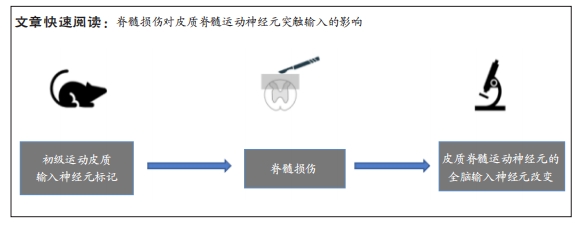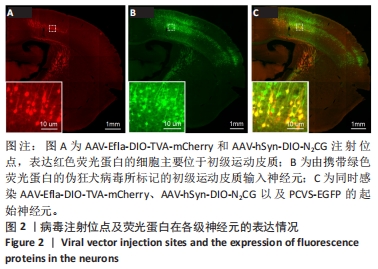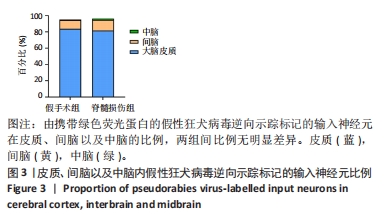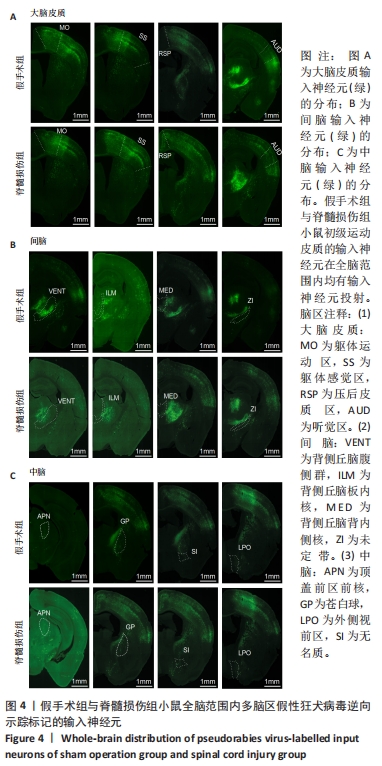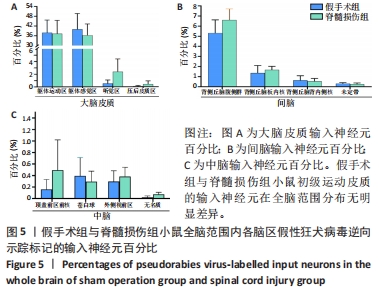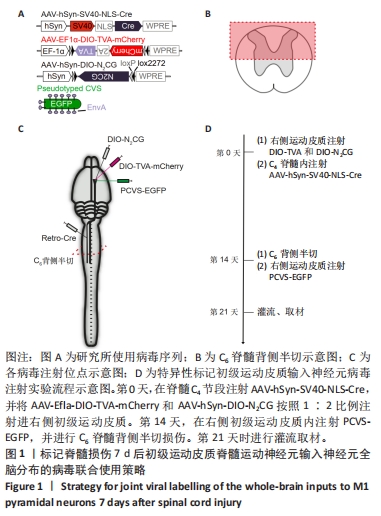[1] BENEDETTI B, WEIDENHAMMER A, REISINGER M, et al. Spinal Cord Injury and Loss of Cortical Inhibition. Int J Mol Sci. 2022;23(10):5622.
[2] WELNIARZ Q, DUSART I, ROZE E. The corticospinal tract: Evolution, development, and human disorders. Dev Neurobiol. 2017;77(7):810-829.
[3] NISHIMURA Y, ISA T. Cortical and subcortical compensatory mechanisms after spinal cord injury in monkeys. Exp Neurol. 2012;235(1):152-161.
[4] COURTINE G, GERASIMENKO Y, VAN DEN BRAND R, et al. Transformation of nonfunctional spinal circuits into functional states after the loss of brain input. Nat Neurosci. 2009;12(10):1333-1342.
[5] WICKERSHAM IR, LYON DC, BARNARD RJ, et al. Monosynaptic restriction of transsynaptic tracing from single, genetically targeted neurons. Neuron. 2007; 53(5):639-647.
[6] ZHANG S, XU M, CHANG WC, et al. Organization of long-range inputs and outputs of frontal cortex for top-down control. Nat Neurosci. 2016;19(12):1733-1742.
[7] DONOGHUE JP, PARHAM C. Afferent connections of the lateral agranular field of the rat motor cortex. J Comp Neurol. 1983;217(4):390-404.
[8] BROWN CE, AMINOLTEJARI K, ERB H, et al. In vivo voltage-sensitive dye imaging in adult mice reveals that somatosensory maps lost to stroke are replaced over weeks by new structural and functional circuits with prolonged modes of activation within both the peri-infarct zone and distant sites. J Neurosci. 2009;29(6):1719-1734.
[9] FOUAD K, PEDERSEN V, SCHWAB ME, et al. Cervical sprouting of corticospinal fibers after thoracic spinal cord injury accompanies shifts in evoked motor responses. Curr Biol. 2001;11(22):1766-1770.
[10] NISHIMURA Y, ISA T. Compensatory changes at the cerebral cortical level after spinal cord injury. Neuroscientist. 2009;15(5):436-444.
[11] NISHIMURA Y, ONOE H, MORICHIKA Y, et al. Time-dependent central compensatory mechanisms of finger dexterity after spinal cord injury. Science. 2007;318(5853):1150-1155.
[12] HAWASLI AH, RUTLIN J, ROLAND JL, et al. Spinal Cord Injury Disrupts Resting-State Networks in the Human Brain. J Neurotrauma. 2018;35(6):864-873.
[13] MARTINEZ M, DELCOUR M, RUSSIER M, et al. Differential tactile and motor recovery and cortical map alteration after C4-C5 spinal hemisection. Exp Neurol. 2010;221(1):186-197.
[14] QIAN J, WU W, XIONG W, et al. Longitudinal Optogenetic Motor Mapping Revealed Structural and Functional Impairments and Enhanced Corticorubral Projection after Contusive Spinal Cord Injury in Mice. J Neurotrauma. 2019;36(3):485-499.
[15] HILTON BJ, ANENBERG E, HARRISON TC, et al. Re-Establishment of Cortical Motor Output Maps and Spontaneous Functional Recovery via Spared Dorsolaterally Projecting Corticospinal Neurons after Dorsal Column Spinal Cord Injury in Adult Mice. J Neurosci. 2016;36(14):4080-4092.
[16] DANCAUSE N, BARBAY S, FROST SB, et al. Extensive cortical rewiring after brain injury. J Neurosci. 2005;25(44):10167-10179.
[17] FLORENCE SL, TAUB HB, KAAS JH. Large-scale sprouting of cortical connections after peripheral injury in adult macaque monkeys. Science. 1998;282(5391):1117-1121.
[18] HAINS BC, BLACK JA, WAXMAN SG. Primary cortical motor neurons undergo apoptosis after axotomizing spinal cord injury. J Comp Neurol. 2003;462(3):328-341.
[19] LEE BH, LEE KH, KIM UJ, et al. Injury in the spinal cord may produce cell death in the brain. Brain Res. 2004;1020(1-2):37-44.
[20] NIELSON JL, STRONG MK, STEWARD O. A reassessment of whether cortical motor neurons die following spinal cord injury. J Comp Neurol. 2011;519(14):2852-2869.
[21] WANNIER T, SCHMIDLIN E, BLOCH J, et al. A unilateral section of the corticospinal tract at cervical level in primate does not lead to measurable cell loss in motor cortex. J Neurotrauma. 2005;22(6):703-717.
[22] NIELSON JL, SEARS-KRAXBERGER I, STRONG MK, et al. Unexpected survival of neurons of origin of the pyramidal tract after spinal cord injury. J Neurosci. 2010; 30(34):11516-11528.
[23] MCBRIDE RL, FERINGA ER, GARVER MK, et al. Retrograde transport of fluoro-gold in corticospinal and rubrospinal neurons 10 and 20 weeks after T-9 spinal cord transection. Exp Neurol. 1990;108(1):83-85.
[24] BARRON KD, DENTINGER MP, POPP AJ, et al. Neurons of layer Vb of rat sensorimotor cortex atrophy but do not die after thoracic cord transection. J Neuropathol Exp Neurol. 1988;47(1):62-74.
[25] TAKATA Y, YAMANAKA H, NAKAGAWA H, et al. Morphological changes of large layer V pyramidal neurons in cortical motor-related areas after spinal cord injury in macaque monkeys. Sci Rep. 2023;13(1):82.
[26] NAGENDRAN T, TAYLOR AM. Unique Axon-to-Soma Signaling Pathways Mediate Dendritic Spine Loss and Hyper-Excitability Post-axotomy. Front Cell Neurosci. 2019;13:431.
[27] KIM BG, DAI HN, MCATEE M, et al. Remodeling of synaptic structures in the motor cortex following spinal cord injury. Exp Neurol. 2006;198(2):401-415.
[28] GHOSH A, PEDUZZI S, SNYDER M, et al. Heterogeneous spine loss in layer 5 cortical neurons after spinal cord injury. Cereb Cortex. 2012;22(6):1309-1317.
[29] NAGENDRAN T, LARSEN RS, BIGLER RL, et al. Distal axotomy enhances retrograde presynaptic excitability onto injured pyramidal neurons via trans-synaptic signaling. Nat Commun. 2017;8(1):625.
[30] CHO Y, SLOUTSKY R, NAEGLE KM, et al. Injury-induced HDAC5 nuclear export is essential for axon regeneration. Cell. 2013;155(4):894-908.
[31] KRUSE F, BOSSE F, VOGELAAR CF, et al. Cortical gene expression in spinal cord injury and repair: insight into the functional complexity of the neural regeneration program. Front Mol Neurosci. 2011;4:26.
[32] POPLAWSKI GHD, KAWAGUCHI R, VAN NIEKERK E, et al. Injured adult neurons regress to an embryonic transcriptional growth state. Nature. 2020;581(7806):77-82.
[33] BRADKE F, FAWCETT JW, SPIRA ME. Assembly of a new growth cone after axotomy: the precursor to axon regeneration. Nat Rev Neurosci. 2012;13(3):183-193.
[34] DI GIOVANNI S, DE BIASE A, YAKOVLEV A, et al. In vivo and in vitro characterization of novel neuronal plasticity factors identified following spinal cord injury. J Biol Chem. 2005;280(3):2084-2091.
[35] ALJOVIĆ A, JACOBI A, MARCANTONI M, et al. Synaptogenic gene therapy with FGF22 improves circuit plasticity and functional recovery following spinal cord injury. EMBO Mol Med. 2023;15(2):e16111.
[36] WANG Z, MEHRA V, SIMPSON MT, et al. KLF6 and STAT3 co-occupy regulatory DNA and functionally synergize to promote axon growth in CNS neurons. Sci Rep. 2018;8(1):12565.
[37] URBAN ET 3RD, BURY SD, BARBAY HS, et al. Gene expression changes of interconnected spared cortical neurons 7 days after ischemic infarct of the primary motor cortex in the rat. Mol Cell Biochem. 2012;369(1-2):267-286.
[38] SANDROW-FEINBERG HR, HOULÉ JD. Exercise after spinal cord injury as an agent for neuroprotection, regeneration and rehabilitation. Brain Res. 2015;1619:12-21.
[39] CHENG X, MAO GP, HU WJ, et al. Exercise combined with administration of adipose-derived stem cells ameliorates neuropathic pain after spinal cord injury. Neural Regen Res. 2023;18(8):1841-1846.
[40] KUMRU H, FLORES A, RODRÍGUEZ-CAÑÓN M, et al. Non-invasive brain and spinal cord stimulation for motor and functional recovery after a spinal cord injury. Rev Neurol. 2020;70(12):461-477.
[41] SONG QF, CUI Q, WANG YS, et al. Mesenchymal stem cells, extracellular vesicles, and transcranial magnetic stimulation for ferroptosis after spinal cord injury. Neural Regen Res. 2023;18(9):1861-1868.
[42] LUO Y, FAN L, LIU C, et al. An injectable, self-healing, electroconductive extracellular matrix-based hydrogel for enhancing tissue repair after traumatic spinal cord injury. Bioact Mater. 2021;7:98-111.
[43] LI G, ZHANG B, SUN JH, et al. An NT-3-releasing bioscaffold supports the formation of TrkC-modified neural stem cell-derived neural network tissue with efficacy in repairing spinal cord injury. Bioact Mater. 2021;6(11):3766-3781.
[44] LIU H, XU X, TU Y, et al. Engineering Microenvironment for Endogenous Neural Regeneration after Spinal Cord Injury by Reassembling Extracellular Matrix. ACS Appl Mater Interfaces. 2020;12(15):17207-17219.
|
